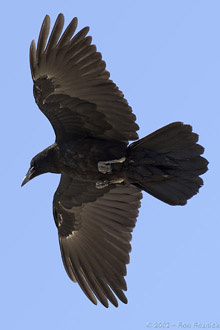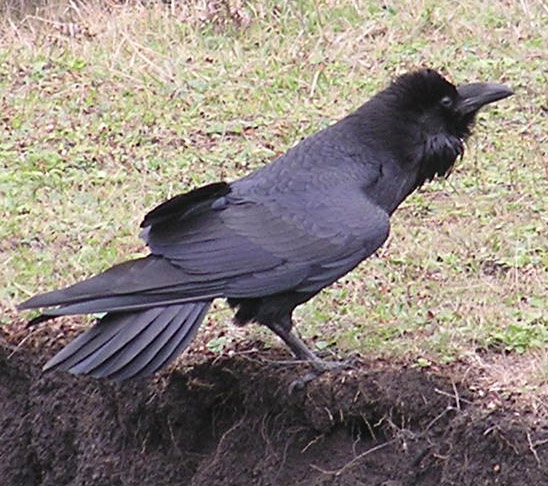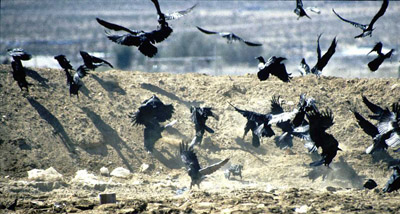
Common Raven photo Ali Giannak.
The Common Raven has a dual image, bird of life and death, friend and foe. The aerial acrobatics of ravens playing on the updraft of local bluffs endlessly entertain me. Their long, wedge-shaped tails twist and turn to steer them left or right, up or down but the wind does most of the work. I watched a pair circle my house and land atop a Monterey Cypress as easily as stepping on a stair. They spread their wings and the airstream lifted them effortlessly. Midway to Caspar one flew inverted beneath the other and they locked their talons in flight. Such skill suggests intelligence.
Bernd Heinrich studies ravens in New England and has written two books about them; Ravens in Winter and Mind of the Raven, Investigations and Adventures with Wolf-Birds. He concludes that ravens are able to manipulate mental images for solving problems. In his view, they are aware of some aspects of their private reality, seeing with their minds at least some of what they see with their eyes.
A closer look at these fascinating birds reveals their talents and the reason Heinrich calls them “Wolf-Birds”. Members of the Corvid family, ravens belong with Jays, Crows, Magpies and Nutcrackers. Properly called the Common Raven, they average 24 inches long, with a wingspan of 53 inches and weigh about 2.6 pounds. By comparison, the American Crow, which does not occur here on the coast, weighs one pound. Raven’s long, heavy bill protrudes above a shaggy throat. In June, July and August you may distinguish juvenile birds by their gray-based neck feathers.
They have an incredible range of sounds, from deep baritone croaks to high, bell-like twanging notes. I particularly enjoy the female “knock-knock” resonant, hollow notes. But ravens are not all song and aerial dance.
Bernd Heinrich calls ravens “Wolf Birds” for good reason, they scavenge carcasses whether fish, fowl or mammal, raid garbage, and rob nests of eggs and young. Ravens will hide or cache food supplies. They also have the habit, like most hawks and owls, of regurgitating undigested food in the form of a pellet.
Ravens look at most of the world as if it is on the menu. They follow wolf packs through snowy backwoods, scavenging from their kills. Where wolves are scarce they follow roads, eating roadkill. They pick at mussels, dead seals and whales on the high-tide line, or gather at riverbanks where crayfish and salmon wash up.
You will attract ravens to your yard if you leave out large amounts of seed, grain, or pet food, or simply fail putting the top securely on your garbage can. These tactics will also attract rodents and other pest animals to your yard. These unwanted scavengers and predators will destroy eggs and chicks allowing insects that birds eat to flourish.

Common Raven photo Donald Shephard.
Ravens, therefore, are not popular with local birders. One pillar of the Mendocino Coast Audubon Society (MCAS) even accelerated her car in an attempt to rid the world of a raven scavenging roadkill. Today, ravens see our sprawling landfills and overloaded dumpsters as so many carcasses where the meat is never finished. Well-fed ravens fatten up, pair off, and make more ravens. Still hungry, or perhaps just bored, they drift through redwood forests and steal threatened murrelet eggs.
Sadly, Common Ravens have followed the human trash trail to our beaches where they turn into demon birds that have mastered the technique of locating shorebird nests on sand. Tracks to the nests of incubating shorebird parents provide landing strips for Common Ravens. Humboldt County researchers have abandoned building structures, called exclosures, that protected shorebird nests because they attracted raids by other predatory birds. Ravens rate number one among consumers of shorebird eggs and, along with careless humans, have contributed to the tragic loss of nesting Western Snowy Plovers on Ten Mile Beach and Virgin Creek.
Becky Bowen, leader of the Save Our Shorebirds (SOS) program for MCAS, has seen them hang out with Turkey Vultures and Gulls on our beaches and notes they mimic shorebird-like behavior by digging with beaks for arthropods in wet sand. They are opportunistic, omnivorous feeders that regard precious shorebird eggs and cotton ball sized young as tasty morsels and easy pickings.
Becky tells me, “Ravens on the beech—arg –ptui. Our SOS Common Raven observations are significant to our research. We observed fewer Common Ravens in 2008 (compared to 2007), but the casual observations from 2009 winter surveys tell us they will be back in force during this summer. On a Ten Mile Beach survey on April 24, 2009, we counted 14 Common Ravens very near Ward Avenue and a pair of Western Snowy Plovers.”
Do not feed ravens. You can help protect the shorebirds by keeping garbage covered and picking up any trash especially foodstuff. More garbage means more ravens and more nest depravation. Keeping our beautiful coast clean helps nature maintain its balance between friends and foes.

Common Raven photo Ron LeValley.
Back to ...
Mendocino Coast Audubon Society Newsletter Articles |
Home page


